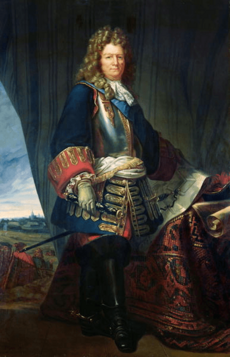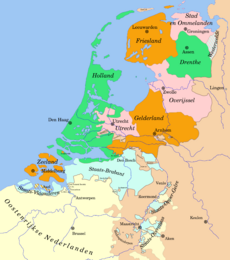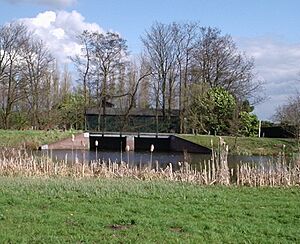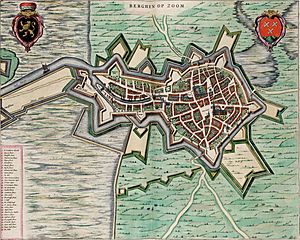Menno van Coehoorn facts for kids
Menno, Baron van Coehoorn (March 1641 – 17 March 1704) was a famous Dutch soldier and engineer. He is known as one of the most important people in Dutch military history. During his time, wars often involved attacking and defending strong forts, known as siege warfare. Menno van Coehoorn and his French rival, Vauban, were the top experts at building, attacking, and defending these forts.
Both engineers had their own ways of doing things. Vauban believed in using "more powder, less blood," meaning he used more cannons to break down defenses, which took longer. This was important because many soldiers died from diseases, not just fighting. Vauban was also seen as more creative in designing forts, even planning whole towns around them.
However, Van Coehoorn had less money to work with. He was very skilled at making the most of what he had, especially adapting his designs to the flat, wet land of the Netherlands. Some of his water defenses and designs were so good that they were still used in the 1950s!
Quick facts for kids
Menno, Baron van Coehoorn
|
|
|---|---|

Menno, Baron van Coehoorn.
|
|
| Born | March 1641 Britsum, Friesland, Dutch Republic |
| Died | 17 March 1704 (aged 62–63) The Hague, Dutch Republic |
| Buried |
Wijkel
|
| Allegiance | |
| Service/ |
Infantry, then Engineers |
| Years of service | 1657 – 1704 |
| Rank | Lieutenant General Ingenieur Generaal der Fortificatiën General of Artillery |
| Commands held | Garrison Commander Namur 1692 Zeelandic Flanders 1702 |
| Battles/wars |
|
Contents
The Early Life of Menno van Coehoorn
Menno van Coehoorn was born in March 1641 in a place called Britsum. This was in the Dutch province of Friesland. He was one of six sons born to Goosewijn van Coehoorn and Aaltje van Hinckena. His family owned a property called Lettinga State near Leeuwarden.
Menno's father, Goosewijn, was an officer in the Dutch army. The family came from Germany, and Menno's great-grandfather had joined the army of William the Silent, a famous leader of the Dutch Revolt.
Menno and his brothers were taught at home. He was very good at math and drawing military plans. Later, he went to the University of Franeker. There, his uncle, Bernardus Fullenius, who was a math professor, helped him.
Menno married Magdalena van Scheltinga in 1678. They had four children: Goosewijn, Gertruda, Hendrik, and Amalia. After Magdalena died in 1683, he married Truytje van Wigara. Menno van Coehoorn died on 17 March 1704 and was buried in Wijckel.
Menno's Military Start
In 1657, when Menno was just 16, he became a Lieutenant in his father's army company. This company was stationed in Maastricht. He was promoted to captain in 1660.
His first experience in battle was in 1665 during the Second Anglo-Dutch War. He helped fight off an invasion by the Bishop of Münster. From 1672 to 1678, he fought in the Franco-Dutch War. He was hurt defending Maastricht in 1673. He also fought in battles at Grave and Seneffe in 1674.
Just before the Cassel in 1677, he became a major. By the end of the war, he was a Lieutenant-Colonel.
The year 1672 is still known as the Rampjaar in the Netherlands, meaning "Year of Disaster." Many important forts fell quickly to the French army. This showed that the Dutch defenses were not strong enough. This led to big discussions about where to build new forts and how to design them for the flat Dutch land.
How Van Coehoorn Designed Forts
Van Coehoorn shared his ideas in a public discussion about building a new fort at Coevorden. He was debating with Captain Louis Paen. In 1682, Van Coehoorn published a book called Fortification of the Pentagon and all its outer works. Then, in 1685, he published his most famous book, New Fortress Construction on a Wet or Low Horizon.
Most countries at that time could not afford huge armies. So, permanent forts were built to slow down an enemy. This gave time for a country to gather more soldiers. In 1672, the Dutch were almost defeated because the French captured forts so quickly. The Dutch were saved only by flooding parts of the land, known as the Hollandic Water Line.
Van Coehoorn understood that the flat land and high building costs meant that forts alone couldn't protect the Netherlands. His designs included these main ideas:
- Active Defense: Defenders should constantly attack the enemy, not just hide behind walls. This meant having open areas inside the forts for soldiers to gather for counter-attacks.
- Multiple Defense Lines: Old forts often had defenses all around. If one part was broken, the whole fort could fall quickly. Van Coehoorn created many "Inner" and "Outer" defense areas. These areas would force attackers through deadly "killing zones" where they could be shot from many sides. These defenses were hidden by being low to the ground.
- Using the Land: He protected his forts by digging wet and dry ditches. The dry ditches were dug almost to the water level. If attackers tried to dig through, they would quickly be flooded out.
Van Coehoorn said that the high water level in the Netherlands made it harder for enemies to dig tunnels under forts. This meant he needed less building material than French forts. Water was a key part of his work. He designed the Zuider Waterlinie between Sluis and Nijmegen. Even after his death, his ideas for a defensive line using the IJssel river were used in the 1950s by NATO.
Namur: Battles in 1692 and 1695
Van Coehoorn's ideas were first tested during the Nine Years' War (1688-1697). This war focused a lot on moving armies and attacking forts. He was at the capture of Kaiserswerth and Bonn in 1690. His exact role isn't clear, but Frederick I offered him a high position in the Prussian army, which he turned down.
Van Coehoorn finally got to use his ideas when he became commander of Namur in 1691. Namur was split into two parts: the "City" on flat land and the "Citadel" on a hill. The Citadel controlled access to the rivers. He made the Citadel stronger with new outer defenses. However, he didn't have time to do the same for the City area. The 5,000 soldiers defending Namur were too few for an active defense, and many were poorly trained Spanish troops.
In the Siege of Namur in 1692, the City fell in less than five days. But the Citadel, with its 500 Dutch defenders, held out until June 30. This was partly because of a deal Van Coehoorn made. He agreed not to fire on the City from the Citadel if the French didn't attack from that direction. As Vauban noted, this made the Citadel almost impossible to capture.
Even so, the defense was a big success. William III made him a Major-General and commander of the important city of Liège. Van Coehoorn also oversaw building new defenses at Huy. The Dutch lost Huy in July 1693 but took it back in September 1694.

The main event of the 1695 Allied campaign was the second Siege of Namur. Vauban had made the forts even stronger. Marshall Boufflers defended it with 13,000 soldiers. Van Coehoorn was in charge of the attack. He quickly captured the outer City. By mid-August, the Citadel was still mostly intact, and William was getting impatient.
On August 21, a huge battery of 200 cannons started firing non-stop for 24 hours on the Citadel's lower defenses. Attacks on the broken walls were very bloody. On August 30, 3,000 soldiers were killed in just three hours. But the defenders finally gave up on September 4.
The two sieges of Namur made Van Coehoorn very famous. His book Nieuwe Vestingbouw was translated into many languages and printed often. His ideas were used in other places like Mannheim and Belgrade. Interestingly, Boufflers' defense of Namur was a great example of Van Coehoorn's own defensive ideas. Boufflers showed that you could win a campaign by losing a fort but tiring out the attacking army.
Both Vauban and Van Coehoorn used a new idea: focusing all their cannons on specific points. Before, armies would shoot at many different areas. Overwhelming defenses with massive firepower became known as the "Van Coehoorn method." Vauban preferred a slower approach, using "more powder, less blood." Both methods had their supporters. The main difference was time, which was important because more soldiers died from disease than from fighting.
Later Military Service
Because of his great service, Van Coehoorn was promoted to Lieutenant General. He also became the chief engineer for fortifications and a general of artillery. His brother Gideon took over his old army regiment. Van Coehoorn himself moved to a Holland regiment, which gave him more power because he now reported directly to William III.
The Treaty of Ryswick in 1697 allowed the Dutch to place soldiers in towns in the Spanish Netherlands. These towns included Nieuwpoort, Charleroi, Luxembourg, Mons, and Namur. This created a buffer zone, or a "defense-in-depth," which was later made official in the 1715 Barrier Treaty.
Van Coehoorn was put in charge of all the Dutch Republic's forts. He was good at changing his designs to fit each location and keeping costs low. This was very important because the Dutch didn't have enough money for all the needed repairs and additions.
Nijmegen and Bergen op Zoom were the first to be upgraded. However, they were not finished when the War of the Spanish Succession began. Van Coehoorn was made Governor of Sluis and military commander in Zeelandic Flanders.
Armies in the Nine Years' War were often very large, sometimes over 100,000 men. This was too many for the countries to support easily. Marlborough, the Allied commander, thought that winning one big battle was better than capturing 12 forts.
Van Coehoorn agreed with this idea. However, the Dutch had survived a century of almost constant war by keeping their army together. They thought losing one battle could lose them the whole war. So, they saw Marlborough's plan as too risky.
Instead, in 1702 and 1703, they focused on taking towns like Venlo and Roermond in the modern Dutch province of Limburg. They also captured Liège, Bonn, and Huy. The war strategy was complicated by different goals between England and the Dutch Republic. The States of Holland did not want to attack Ostend and Antwerp in 1703. They worried it would hurt Amsterdam's control over the Scheldt river trade.
Because of this confusion, a Dutch army was surrounded by a much larger French force at Ekeren on June 30. They barely escaped. Van Coehoorn was blamed for this, whether it was his fault or not. He was known to be a difficult person, and William III's death meant he lost his most powerful supporter. The campaigns of 1702 and 1703 showed his weaknesses as a field officer, and he was criticized by Marlborough and other Dutch officers.
He was thinking about joining the army of Savoy when he died on 17 March 1704 in The Hague. He was attending a meeting with Marlborough at the time. The States of Friesland paid for a monument over his grave in Wijckel.
Other Achievements
In May 1701, Van Coehoorn showed William III a new, light-weight mortar. This weapon was later called the Coehorn mortar. It was designed to help infantry soldiers when they attacked. It was first used in 1702 at Kaiserworth. Different versions of this mortar were even used during the US Civil War in 1861.
Van Coehoorn also worked on important civil projects. He helped rebuild dikes along the Lower Scheldt river. He also designed new barrages (dams) along the Zuiderzee.
The Menno van Coehoorn Foundation was started in 1932. Its goal is to protect the historical forts in the Netherlands and the wildlife around them.
His son, Gosewijn Theodor van Coehoorn (1678–1736), wrote a book about his father called The Life Of Menno Baron Van Coehoorn. This book is still available today.





